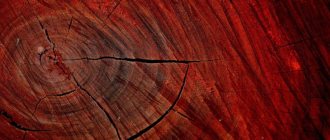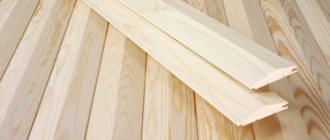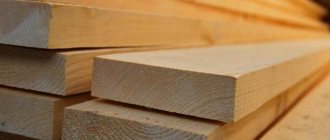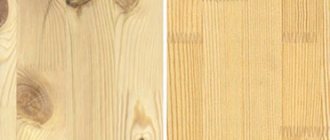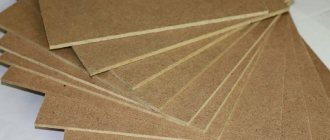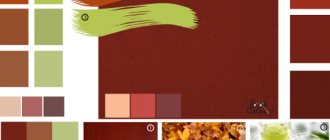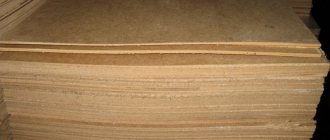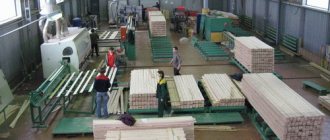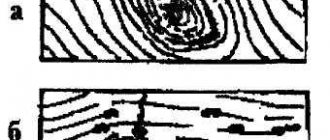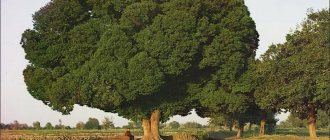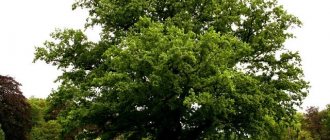Almost every person sooner or later is faced with the need for repairs or even small construction. True, there is usually not enough time for anything. Manufacturers of building materials understand everything and try to manufacture their products in such a way as to ensure the fastest possible completion of installation work. First of all, these are wood-based sheet materials. Let's look at how their varieties differ and, most importantly, where to use them.
Chipboard (chipboard)
A material made from large wood shavings, which are held together with glue under the influence of a press. This building material is easy to process and also has a low cost compared to other sheet materials.
Chipboard is used for making subfloors, lining ceilings, and making internal partitions. The downside is that when installing chipboard sheets it is difficult to use fastening elements - self-tapping screws and self-tapping screws are poorly screwed.
Learn about the benefits of building walls using autoclaved aerated concrete.
Wood-laminated board (plywood)
A material based on wood veneer. The peculiarity of this type of sheet material is that the veneer layers are laid perpendicular to each other and connected under a press with the introduction of a binder component. The material has high strength and is hygroscopic. The plywood sheet has a thickness from 4 to 24 mm.
Plywood is used in the creation of formwork, some sections of roofs, in the construction of scaffolding, wooden structures as part of building facades, as well as in the cladding of buildings. When decorating the interior, plywood is used to make soundproofing panels, window sills, doors, elevator cladding and various surface cladding.
Medium density fiberboard (MDF)
It is made by pressing wood chips under high pressure and temperature. Carbide resins are used as an adhesive composition.
MDF panels are widely used in decoration. Now they are actively used for repairing and decorating ceilings and masking air ducts. They are used to make interior doors and window sills. There is also a type of high-density MDF - HDF. It is well suited for the production of laminated flooring, partition boards and ducts for heating appliances.
Fiberboard (Fiberboard) or hardboard
Sawdust and small wood shavings compressed under high temperature using a special additive for gluing. The additive serves as a binding component, its content is quite low. This classifies fiberboard as an environmentally friendly building material. The sheets have a thickness of 3.2-5 mm.
In construction, hardboard or fiberboard has found wide application:
- insulation of floors;
- production of soundproof partitions;
- as a thermal insulation material;
- when installing formwork;
- as a facing material for walls;
- for roughing and finishing floor processing;
- to create a panel for a distribution board.
Fiberboard is a material that can be used in rooms with low humidity. It cannot be used in damp areas.
Properties of wood materials used in construction
Wood materials have been used in construction since ancient times, and they remain modern in the 21st century. A high coefficient of structural quality, strength indicators, manufacturability and decorativeness have provided wooden structures and wood products with a worthy place in building structures. Another important property of such a material as wood is its high resistance in aggressive environments.
Gluing wood with modern polymer adhesives makes it possible to obtain composite materials. The use of laminated timber structures, which are classified as lightweight prefabricated industrial structures, allows to reduce construction time and reduce its cost.
The main property of wood building materials is their strength. The average strength of hardwood and softwood does not exceed 40-52 MPa in compression along the fibers, 80-100 MPa in bending, PO-129 MPa in tension along the fibers. Considering that these results were obtained on small-sized elements at 15% humidity in laboratory conditions, the strength of long-sized elements will be lower due to wood defects. When calculating wooden structures for bending and compression, the strength is assumed to be no more than 10-12 MPa. In glued structures, where flaws and defects are reduced to a minimum during their manufacture, the strength increases several times. In wood-laminated boards (chipboards) the strength reaches 150-260 MPa.
The potential of wood materials in construction is very great and the strength characteristics increase significantly in composite materials. An effective combination of building materials made of wood with metals, polymers, fibers, and mineral binders constitutes a fundamentally new basis for the creation of wooden structures.
Oriented strand board (OSB)
It is made from thin chips up to 150 mm long by pressing with the introduction of additional components - resin, boric acid, synthetic wax. Refers to durable types of sheet building materials. One sheet has a thickness of 9-10 mm. There are three types of OSB: varnished, laminated and tongue-and-groove.
OSB is used both for the renovation of premises and for the construction of low-rise buildings. Many owners of land plots begin to equip them by erecting a utility block, temporary housing or a shed made of OSB - such construction is cheap, fast and convenient.
Basically, oriented strand boards are used for such types of work as:
- Floor installation. The OSB board is a smooth, durable and stable surface.
- Walling. When building houses from oriented strand boards, only boards marked OSB-3 are used, and the surface of the material must be primed and sealed.
- Installation of partitions. The marking depends on the humidity in the room - it can be either OSB-2 or moisture-resistant OSB-3. The use of a coating that is resistant to various types of liquids will in the future make it possible to carry out finishing using varnishes or water-based paints - they allow vapors to escape well and create an optimal microclimate.
- Construction of cottages from sandwich panels. These panels are monolithic, stable structures made of two OSB boards, between which there is insulation. Thanks to this method, the cost of construction and the time of its construction are significantly reduced due to economical and convenient building materials.
Classification of wood by heartwood and sapwood
- The color of wood depends on the type of tree, age, speed and location of growth.
- The intensity of the color depends on the concentration of tannins, resins, and dyes in the wood.
The heartwood is the dead wood inside the trunk. As a rule, the core of the trunk is darker than the sapwood. This is due to the fact that as living cells inside the trunk die, tannins and dyes are deposited in them, since the water supply pathways are clogged.
It is tannins and dyes, as well as resins and calcium carbonate that contribute to the coloring of the central part of the trunk in darker colors.
The lighter wood around the core is a layer of living cells called sapwood. The wood core is the hardest part of the trunk. It is denser than sapwood and has greater resistance to rotting.
All wood species are divided into three groups:
Heartwood species have dead cells in the center of the trunk, which are darker in color. Sound tree species include trees such as larch, oak, pine, cedar, apple, juniper, ash
Cutting down an apple tree
Sapwood does not have dead cells. Sapwood species include maple, linden, pear, birch
Cutting down a birch
Mature wood is considered to be wood where the color of the sapwood does not differ from the color of dead cells, for example, beech wood
Beech cut down
Cement particle board (CSP)
A high-strength, moisture-resistant building product, made by combining cement with thin wood shavings. This material is distinguished by its durability and has good sound and heat insulation properties. DSP is easy to work with and process, just like wood. But unlike the latter, insects, rodents, and fungal bacteria do not grow in the DSP. Cement provides good resistance to ignition, and wood chips prevent the slab from cracking from frost or high air temperatures.
The listed factors make it possible to use slabs as a material for covering walls both inside and outside the building in various climate conditions:
- Cement particle boards, included in the “pie” of the building’s walls, ensure heat retention inside it. They are convenient to use for finishing walls in private construction, both in dry and “wet” rooms.
- For the construction of internal partitions, larger CBPBs are used, and narrower ones are used for wall cladding. Using an unusual coating, you can turn even the most dull furnishings in your home into a designer one.
- DSP sheets are perfect for rough finishing; for example, a floor leveled with their help will be perfectly smooth and warmer throughout its entire service life.
The price of sheet wood materials varies significantly depending on their type, thickness, size and grade. You can buy high-quality sheets wholesale and retail with fast delivery from the warehouse closest to you on the WhereMaterial website.
Lecture 13. Wood and materials made from it
Transcript
1 Lecture 13 Wood and materials made from it Wood has long been used in construction due to a number of useful properties: high strength, low density, low thermal conductivity, ease of processing, simplicity of connections, chemical resistance, decorativeness. The negative characteristics of wood are: hygroscopicity, swelling, shrinkage, presence of defects, flammability, susceptibility to rotting. A specific feature of wood is anisotropy of properties (differences in different directions). The growth period for industrial trees is years. Waste during processing sometimes reaches 50-60%. These wastes and non-commercial wood are subjected to deep processing in order to obtain full-fledged building materials. Depending on the degree of wood processing, the following are distinguished: forest materials obtained by mechanical processing of tree trunks (logs, lumber); wooden products and structures manufactured in factories (door and window blocks, glued structures, plywood, etc.) materials obtained by technological processing of wood: particle boards (chipboards), wood concrete, fiberboard, fibreboards (fibreboard), cardboard, paper. Structure of wood On a cross section of a tree trunk, the following parts can be distinguished: bark, wood, core. Bark is the outer layer covering the trunk of a tree. Wood consists of annual layers; inside these layers are impregnated with tannins or resin. In the inner layers, the movement of moisture therefore stops and this part of the trunk is called the core. In the outer annual layers this movement is preserved and this part of the trunk is called sapwood.
2 Defects of wood Defects are defects in wood that appear during tree growth and storage of lumber in a warehouse. The standards for specific types of forest products contain instructions on acceptable defects. They are divided into several groups. Defects in the shape of the trunk: f) growth a) abnormal tapering of more than 1 cm per 1 m of trunk length; b) rooting is a sharp increase in the diameter of the lower part of the trunk (butt), the butting can be ribbed and round, this significantly increases the amount of waste; d, e) - curvature of the trunk, bending in one or more places; Defects in the structure of wood - deviations from the normal arrangement of fibers in the tree trunk: Cross-grained Curly Curl - the inclination of the fibers (cross-cut) non-parallelism of the wood to the longitudinal axis of the lumber; — curliness of wood fibers arranged in the form of waves and curls; — the annual rings have different thicknesses and densities on different sides of the core;
3 Knots are the most common defect, representing the base of tree branches. Knots can be fused or unfused, clawed, or rotten (tobacco). Knots reduce the strength of lumber; the number and location of knots determine the grade of wood. Grown knot Unfused knot Decaying knot Cracks can appear on both a growing tree and a felled tree. a - metic: 1 - simple in round timber; 2 - in lumber with access to the face, edge and end; b - hatching: 1 - in round timber; 2 - in lumber (slab, edge, end); c - shrinkage cracks: 1 - in round timber, 2 - in lumber (face, edge, end); d - frost break: 1 - in round timber, 2 - in Metik lumber, one or more internal cracks running from the center to the periphery along the trunk; frost crack - an external open longitudinal crack, tapering towards the center;
4 peeling partial or complete separation of the central part of the trunk along the annual rings from the peripheral as a result of shrinkage. Shrinkage cracks are formed as a result of uneven drying of wood. Fungal lesions and chemical stains are caused by the simplest living organisms (fungi, microorganisms, wormholes). Wormholes Fungal infections Rot The most important properties of wood Based on humidity, they distinguish between wet (more than 100% humidity); freshly cut (more than 35%); air-dry 15-20%; room-dry 8-12%; absolutely dry wood, dried to constant weight. The standard wood moisture content is 12%. Changes in the moisture content of wood cause changes in its linear dimensions, shrinkage and swelling. Along the fibers, linear shrinkage does not exceed 0.1%, across the fibers 3-6%. Stresses caused by shrinkage can lead to cracks. The true density of wood is 1.54 g/cm3, the average density of wood of many species is below 1000 kg/m3. It is usually compared at a humidity of 12%. Wood porosity is on average 50-70%. The thermal conductivity of wood is relatively low and varies depending on the arrangement of the fibers; in the transverse direction it is two times lower.
5 The strength of wood along the grain is MPa and is comparable to the strength of concrete. The compressive strength across the fibers is 0.15-0.3 of the tensile strength along the fibers. The tensile strength along the fibers is 2-3 times greater than the compressive strength along the fibers and is MPa. The bending strength is MPa. The flexural strength of wood is higher than that of most building materials. The mechanical properties of wood depend on humidity. To obtain comparable results, the strength of wood at actual humidity is recalculated to the strength at standard humidity using the formula: R 12 = RW [1 + α (W 12)]; where R 12 and RW, respectively, are the strength limits of samples at 12% and W humidity at the time of testing, α is a correction factor for humidity, showing how much the strength changes when humidity changes by 1%. The main tree species used in construction. Based on a number of biological characteristics, species are usually divided into coniferous and deciduous. Coniferous species: pine, larch, cedar. Pine is the most common coniferous species. Pine wood is light golden in color, has good physical, mechanical and performance characteristics, and is easy to process. Load-bearing wooden structures and plywood are made from pine. Larch resembles wood, but is denser and stronger, is more resistant to decay, and is characterized by greater resin content. It can be used in underground structures, as piles and for hydraulic structures: bridges, piers. Spruce and fir are common coniferous species, the wood of which is characterized by low resin content but high strength. They are used to make structures used in dry conditions. Cedar is a lightweight, durable and easy to work wood. Hardwoods are used in construction less often than conifers. Of the variety of hardwood species, oak, ash, beech, birch and aspen are used in construction.
6 Oak has a heavy, dense, and very hard wood with a yellowish beautiful texture. It is well preserved in air and water. High-quality parquet, plywood, door and window blocks, and furniture are made from oak. Beech has a dense and durable wood with a yellowish tint. Beech is used to make parquet, plywood, and moldings. Ash is a heavy, hard and durable wood, similar to oak, but lighter in color. Birch is the most common deciduous tree in our forests. Birch wood is hard and durable in dry conditions, but not durable in wet conditions. Aspen has soft and light wood, white with a greenish tint; when wet, it quickly rots. Aspen easily splits along the grain, so it is good to use for making plywood. Wood strength (in the numerator the ultimate strength, MPa at a humidity of 12%, in the denominator 30% or more) Table 13.1 Test Leaf species. S E B K O L D Compression along the fibers 64.5 25.5 48.5 21.0 44.5 19.5 55.0 22.5 45.5 24.0 42.5 19.0 57.5 31, 0 across the grain 4.5 5.7 5.5 — (radial direction) 2.7 3.1 3.4 3.3 Tension along the grain across the grain 5.6-5.4 3.9 5.0-11 ,1 5.7 8.3-7.1-8.0 7.4 Static bending 111.5 61.5 86.0 49.5 79.5 44.0 109.5 59.5 88.0 54, 0 78.0 45.5 107.5 68.0 Shearing along the fibers in the radial plane 9.9 6.3 7.5 4.3 6.9 4.1 9.3 5.0 8.6 5.6 6 .3 3.6 10.2 7.2 in the tangential plane 9.4 5.8 7.3 4.5 6.8 4.4 11.2 5.9 8.1 5.0 8.6 5.0 12.2 9.0 Note: Foliage. larch; C pine; E spruce; B birch; K cedar; Ol' alder; D oak.
7 Comparative characteristics of wood species Table 13.2 Average Rcom, kgf/cm² Total density energy intensity, kg/m³ kg fl/m³ Species name Oak ,5 Ash ,7 Larch ,5 Beech ,7 Birch ,7 Pine ,6 Alder Poplar , 5 Spruce, 6 Cedar Timber and wood products Timber refers to materials made from wood that have preserved its natural structure and composition. They are divided into unprocessed (round) and processed (lumber, chipped, veneer, etc.) Wood products are produced by mechanical processing and joining individual elements into a product. Round timber is delimbed sections of tree trunks. Depending on the diameter of the upper end, they are divided into logs, sub-bars and poles. Logs Podtovarnik Poles Construction logs must have a diameter of the upper end of at least 14 cm, a length within 4-6.5 m, a sanded surface, and the ends are cut at a right angle.
8 In the construction of log houses, rounded logs processed on a lathe without running are becoming increasingly common. The logs have a top diameter of 8-13 cm and a length of 3-9 m. The poles have an upper diameter of 3-8 cm and a length of 3-9 m. These materials are used for auxiliary purposes (fences, small log houses, etc.). ). Lumber is obtained by longitudinal sawing of logs: plates, quarters, slabs, boards, beams. Beams Boards Plates Quarters Boards, depending on the cleanliness of the sawdust and longitudinal edges, are unedged, edged, tongue-and-groove and folded. Unedged boards Edged boards Folded boards Grooved boards The length of the boards is up to 6.5 m with gradation every 0.25 m. Depending on the quality of the wood and its processing, the boards are divided into five grades. High-grade boards are used for the manufacture of elements of wooden structures and joinery. The beams have a square or rectangular cross-section (a:b 2). Beams sawn on both sides are called double-edged, sawn on four sides are called four-edged. The length of the beams corresponds to the length of the logs and is up to 6.5 m. They are used to construct walls, ceilings, and roofs. Moldings, tongue and groove floor boards, skirting boards,
9 Window and door frames, railings, etc. They have a complex topography and are used for flooring and door openings. Skirting boards Platbands Railings Products for parquet floors piece parquet (planks mm long and mm wide with grooves and ridges), panel parquet, parquet boards (laminated three-layer structures consisting of veneer, hardwood and a base of pine or spruce slats). Block parquet Panel parquet Parquet board Plywood three or more sheets of veneer glued together, with fibers arranged perpendicularly. Plywood
10 Joinery products for construction purposes, window and door units, produced at special enterprises, painted and antiseptic. Building structures and parts made of wood: sets of wooden houses, beams, trusses (obtained by gluing). Wooden trusses Wooden house kit
11 Materials from wood waste: particle boards, wood fiber boards, in which wood in the form of shavings or sawdust is used as a filler in combination with a polymer (chipboard) or mineral binder. Such slabs are used for cladding floors, ceilings, walls, and partitions. Particleboards Fiberboards Protection of wooden structures from damage by insects To protect wood from damage by insects, special substances (insecticides) are used, which are divided into: a) materials for protecting the wood of newly built objects, these include coal and shale oils, a solution of copper naphthenate in kerosene or fuel oil; b) materials for protecting wood during its storage in warehouses, or used during repair work, these are hexachlorane, chlorophos, chloropicrin, etc.; Penetrating into wood, insecticides kill the larvae and the insects themselves or create an environment in which the vital activity of insects becomes impossible. Protection of wooden structures and products from fire To protect wood from fire, wooden structures and products are subjected to fire-retardant treatment in various ways: surface coating, painting, coating with asbestos-cement sheets. One of the most effective methods of fire retardant treatment of wooden structures is impregnation of wood with fire solutions.
12 non-protective salts in pressure autoclaves or hot-cold baths, followed by coating with weather-resistant fire-retardant paint. Substances used to protect wooden structures from fire are called fire retardants (ammonium phosphate, ammonium sulfate, borax, boric acid). Various fire-resistant paints are widely used as fire-retardant coatings. Self-test questions 1. What are the positive and negative properties of wood? 2. Describe the structure of wood. 3. Name the main defects of wood. 4. List the main tree species used in construction. 5. What building materials and products can be obtained from wood?
